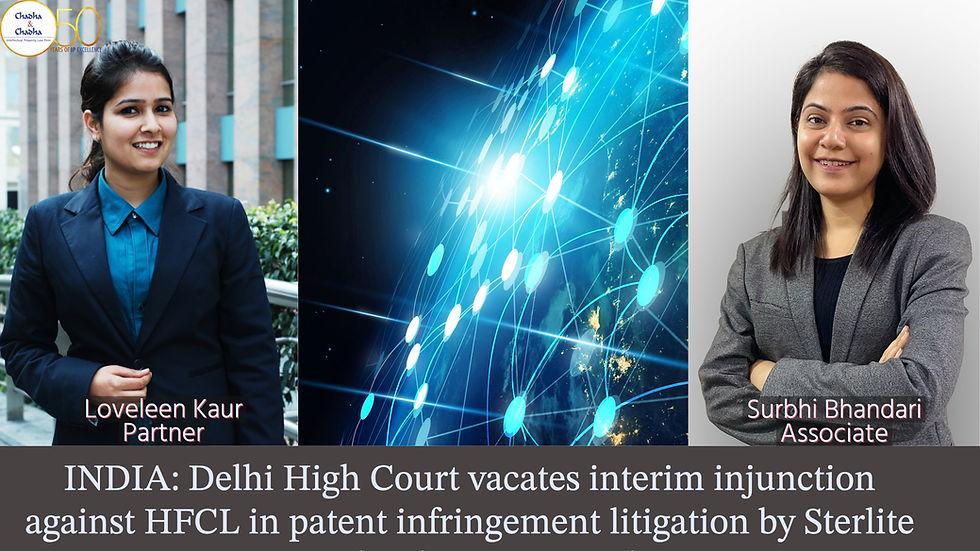High Court vacates injunction against HFCL in patent infringement action by Sterlite Technologies
In a recent judgement passed in the matter of STERLITE TECHNOLOGIES LIMITED vs HFCL LIMITED, the High Court has vacated an ex-parte ad-interim injunction which was earlier granted against the Defendant in connection with the patent infringement suit pertaining to Indian Patent Application Number IN335369.
Background
The present suit was instituted by Sterlite Technologies Limited (hereinafter referred to as he “Plaintiffs”) against HFCL Limited (hereinafter referred to as the “Defendant”) seeking inter alia, a permanent injunction restraining infringement of Indian Patent No. IN335369 related to optical fiber cables (hereinafter referred to as “OFCs”). The Plaintiff asserted that it is engaged in the business of telecom products and solutions, including manufacture and sale of integrated optical fibers and OFCs, and have come across the Defendant’s website with brochures of the Defendant listing several products having substantial similarities to the Plaintiff’s OFC. According to the Plaintiff, the said impugned OFCs of the Defendant violated the Plaintiff’s exclusive rights granted under the suit patent .
Earlier this year, the Court granted an ex-parte ad-interim injunction to the plaintiff vide order dated January 12, 2022. Thereafter, the Defendant filed an application seeking vacation of the injunction, along with its written statement and its counter-claim seeking revocation of the suit patent.
The Defendant primarily argued that the enclosing of 16 optical fibers is the main distinguishing element of the Plaintiff’s Claim 1 and if the optical fibres enclosed are not 16, or are less than or more than 16, such an OFC would not infringe the suit patent. In support of this, the defendants placed reliance on the two pending patent applications of Plaintiff contending that one of them was withdrawn by the Plaintiff during pendency of the present proceedings and the other was filed on the same date of the patent of the present suit, the only distinction between the two specifications being the numbers of fibers 16 and 24.
The Defendant also highlighted two prior arts which were asserted as rendering the suit patent anticipated and obvious. One of these prior arts was also cited by the European Patent Office in its decision of refusal of the counterpart European application. It was argued that the prior arts and the patent of the present suit have similar aramid yarn cross binding feature and they differ only in terms of the number of optical fibers in the sleeve.
The Plaintiff in their rejoinder, claimed that contrary to the Defendant’s submission, the key element of the invention is not the number of optical fibers which are enclosed in the sleeve and the number “16” in Claim 1 of the suit patent is merely illustrative in nature. The Plaintiff further went on to explain that the main invention lies in the strengthening layer arising out of the use of aramid yarn, which is used for binding the optical fibers.
The Plaintiff further urged that cited prior arts cannot be considered, as mosaicing is not permitted.
Findings of the Court
The Court considered both prior arts as valid prior arts and delved upon the concept of the mosaicing, holding that “the Plaintiff’s claim of mosaicing lacks merit. The objection of ‘mosaicing’ would normally apply when completely unconnected documents are presented in a combination to defeat the inventive step in the invention. However, the argument of mosaicing cannot be sustained when there are only two documents used as prior art and such documents are interconnected or disclose similar products. When multiple documents are alleged to disclose substantially similar products to the patented product, then the same is a reflection of the state of the art and not ‘mosaicing’.”
The Court further perused both the prior art documents closely and upon comparative analysis of the product came to the conclusion that all the elements of the suit patent exist in the prior art documents. The only difference lies in the number of fibers enclosed in the sleeve and the placement of water swellable yarn, which was not sufficient to hold that the suit patent is valid, in the opinion of the Court.
The Court also concurred with the Defendant’s claim that the only distinguishing feature of the Plaintiff’s OFC is that it specifies the number of optical fibers in a sleeve as 16. The Court opined that if the intention of the Plaintiff was not to limit the product Claims to 16 fibers, the wording of the Claims ought to have been as a “plurality of or multiple optical fibers”.
While analysing the other two applications filed by the Plaintiff and noting that all three applications relate to similar OFCs with just changes in dimensions, the Court considered both the documents extremely relevant as the facts support the Defendant’s argument regarding main distinguishing feature.
The Court concluded that any person who is skilled in the art, who has knowledge of the prior art documents could have easily made the minor modification of changing the numbers of fibers in the sleeve or adding horizontal water-swellable yarns.
Based on the Court’s analysis, the ex parte injunction granted vide order dated 12th January 2022 was vacated with a disclaimer that the observations made in the present order shall not bind the trial of the suit and are merely prima facie in nature.
It is yet to be seen whether the trial of the suit will eventually lead to invalidation of the suit patent or to a finding of infringement against the Defendant.









































Comments